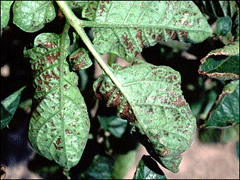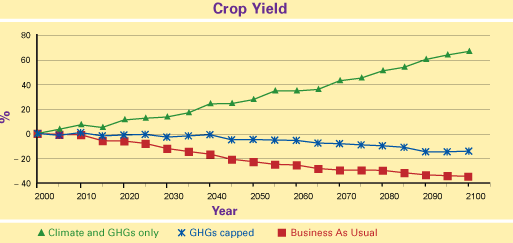Ozone's Harsh Harvest
Air Date: Week of March 14, 2008

Browning patches on potato leaves shows evidence of exposure to high concentrations of ozone. (Photo: North Carolina State University)
Ground-level ozone doesn't just hurt people, it's bad for plants, too. MIT researcher John Reilly tells host Steve Curwood about ozone's global and rural reach on crops.
Transcript
CURWOOD: Ozone is not only bad for the lungs, but it’s also damaging to plants. Ground level ozone turns their leaves brown and spotty, and stunts their growth. It’s particularly noxious to crops. Ozone has already cut cereal production in the U.S. by about five percent, and at the current levels could slash world crop yields nearly 40 percent by the end of the century. Those figures come from John Reilly – he’s associate director of the MIT Joint Program on the Science and Policy of Global Change. He led a recent study on ozone and crops, and joins me now in the studio. Hello, Dr. Reilly.
REILLY: Hello.
CURWOOD: I gather looking at your study that you see ozone pollution as not only a city problem, but a rural problem, and a global one at that.
REILLY: Many years ago when some of the first clean air legislation was passed, I think people thought it was very much as just an urban problem. When measurements have extended, people have realized that the ozone actually lives in the atmosphere for a few months, and so over that time it spreads out across the landscape and in fact, over the course of three months you can have a lot of transport around the entire globe. And so that means that ozone can appear at high levels in different places. The actual ozone levels, then, get higher because the background level is higher.
CURWOOD: Now as I understand it, leaves actually breathe, plants actually breathe. They have these stomata, these openings on their leaves in which they take in air and they let it out. What does ozone do to that process?
REILLY: That’s where the ozone actually enters into the plant. So the plant is trying to use CO2, and that’s one of its basic ingredients that allows it to grow. It’s a little bit like us breathing in, and when we breathe in to get air, that’s when we get ozone damage in our lungs. So it’s kind of a similar process in plants.
CURWOOD: So where there’s a lot of ozone, it’s like us trying to run in heavy traffic?
REILLY: Right. In fact, damage to crops tends to be larger than damage to, you know, other vegetation because we’re usually fertilizing crops, and fertilizing crops is getting them to grow really fast, and it’s like us going out and working really hard, or running really hard. So if you do that and then you have high ozone levels at the time, the damage to crops can be larger than unfertilized vegetation.

John Reilly (left) and his colleagues Benjamin Felzer (center) and David Kicklighter studied the impacts of increases in temperature, carbon dioxide, and ozone concentrations on global vegetation. (Photo: Donna Coveney, MIT)
REILLY: Well, the increase in CO2 is generally beneficial for plants. But changes in climate are, you know, sometimes good and sometimes bad. You know warming in northern areas tends to kind of increase the growing season and actually increase productivity. A lot of warming in the tropics can actually damage productivity. But ozone is damaging.
So we found that as a result of increasing ozone levels, the combination of these could be as much as a 50 to 60 or 70 percent yield decline in temperate regions in China, the U.S., and Europe. So that was a large net effect on crops, so the ozone effect was dominating there.
CURWOOD: How surprised were you by the results of your study?
REILLY: Well I was, you know, dramatically surprised that the results were so negative, and we checked them several times. There is a threshold, 40 parts per billion of ozone in the atmosphere, above which damage starts occurring. What really happened here is that the actual ozone levels only increased 50 percent, but when measured above this threshold, the amount of ozone increased by six-fold. So that was a dramatic increase and led to this high damage.
CURWOOD: So we’re in a time now when we’re seeing rising prices for food already, I guess in part due to the American dollar not being worth as much as it is and the price of oil going up. And now ozone is another factor to limit crop production?

Reilly’s analysis shows that warmer temperatures and increased levels of carbon dioxide in the future could boost crop yields (top curve), but when the effect of rising levels of ground-level OZONE is taken into account, global yields could drop by 40 percent (bottom curve). (Graphic: MIT Energy Initiative)
And then one of the answers to some of these problems are biofuels. And if you had a substantial biofuels program, that would still put more pressure on land resources and food prices.
CURWOOD: What’s to be done?
REILLY: Well, it is possible to select plants that are less sensitive to ozone. But I think one of the key results of this study is this global or hemispheric transport of ozone. So while now individual countries can set standards for their own areas and hope to achieve them, in the future if we don’t control emissions elsewhere, then we will find it difficult to achieve those in our own backyard.
If there is a silver lining to the cloud, it’s that China is also going to experience crop damage from ozone, and it will be very much in their interest to reduce these pollution levels as well.
CURWOOD: John Reilly is associate director of the MIT Joint Program on the Science and Policy of Global Change. Thank you so much, sir.
REILLY: Thank you.
Links
To read John Reilly’s article on ozone and crops, click here
Learn more about the effects of ozone on plants
The MIT Joint Program on the Science and Policy of Global Change
Living on Earth wants to hear from you!
Living on Earth
62 Calef Highway, Suite 212
Lee, NH 03861
Telephone: 617-287-4121
E-mail: comments@loe.org
Newsletter [Click here]
Donate to Living on Earth!
Living on Earth is an independent media program and relies entirely on contributions from listeners and institutions supporting public service. Please donate now to preserve an independent environmental voice.
NewsletterLiving on Earth offers a weekly delivery of the show's rundown to your mailbox. Sign up for our newsletter today!
 Sailors For The Sea: Be the change you want to sea.
Sailors For The Sea: Be the change you want to sea.
 The Grantham Foundation for the Protection of the Environment: Committed to protecting and improving the health of the global environment.
The Grantham Foundation for the Protection of the Environment: Committed to protecting and improving the health of the global environment.
 Contribute to Living on Earth and receive, as our gift to you, an archival print of one of Mark Seth Lender's extraordinary wildlife photographs. Follow the link to see Mark's current collection of photographs.
Contribute to Living on Earth and receive, as our gift to you, an archival print of one of Mark Seth Lender's extraordinary wildlife photographs. Follow the link to see Mark's current collection of photographs.
 Buy a signed copy of Mark Seth Lender's book Smeagull the Seagull & support Living on Earth
Buy a signed copy of Mark Seth Lender's book Smeagull the Seagull & support Living on Earth

